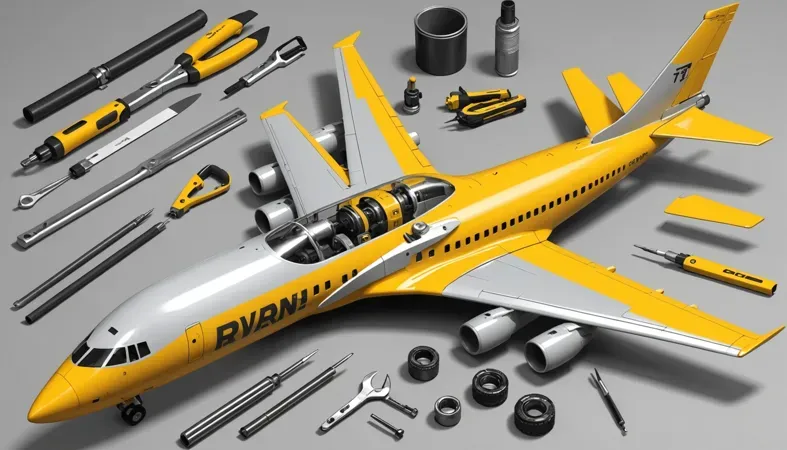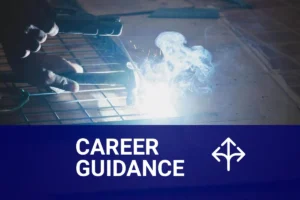How to Become a Welder Apprentice? Steps, Types, and Benefits
Published on: June 8, 2025 | Last modified: March 4, 2025
By: Joe Carter
People often ask us how to become a welder apprentice. It’s crucial to follow the right steps because it sets the stage for your future as a welder. I’ve seen many folks jump in without guidance, and it often leads to confusion and setbacks.
In this guide, we’ll cover what an apprentice is, types of apprentices in welding, prerequisites, how to apply for welding apprenticeship, steps to become a welder apprentice, precautions, and industry applications for welders, along with tips on how long is a welding apprenticeship and what could go wrong. You’ll be able to figure out how to get a welding apprenticeship and understand your options before diving in.
Contents
- How to Become A Welder Apprentice?
- What is an Apprentice?
- Types Of Apprentices in Welding
- Prerequisites
- Precautions
- Steps to Become a Welder Apprentice
- Types Of Welder Apprenticeships
- Factors Influencing Welder Apprenticeships
- How to Find the Right Welder Apprenticeship Program
- Why This is Worth It: Advantages
- Industry Applications for Welders
- What Are the Alternatives to Becoming a Welder Apprentice?
- Frequently Asked Questions (FAQs)
- References
How to Become A Welder Apprentice?
An ‘apprentice’ is someone who learns while working. To become a welder apprentice, find a program, apply, and commit to 2-4 years of training. Expect hands-on experience and a challenging yet rewarding journey in various welding fields.
What is an Apprentice?
An apprentice is a person who learns a trade through hands-on experience under a skilled worker. This often involves a structured program lasting from 1 to 4 years. During this time, apprentices complete about 144 hours of related instruction each year, combined with at least 2,000 hours of on-the-job training annually, enabling them to master the skills needed for the profession.
So, how does one become a welding apprentice? To start, you typically need a high school diploma or GED. I remember when I applied for a welding apprenticeship; I felt excited and nervous. You should prepare to take an assessment test or interview, depending on your application location.
When I worked on a project in a manufacturing plant, I found it helpful to connect with experienced welders. Learning from them during my apprenticeship refined my skills quickly. If you’re wondering how long a welding apprenticeship takes, it can vary, but most programs last between 1 to 5 years. During this time, you gain practical knowledge and experience that sets you up for a successful career.
Types Of Apprentices in Welding
What are the different types of welding apprenticeships?
-
Pipe Welder Apprentices
Pipe welder apprentices focus on joining pipes in structures like refineries and power plants. To start, find a local union or trade school offering a pipe welding program. You’ll need a high school diploma or GED and may have to pass a basic skills test.
-
Structural Welder Apprentices
Structural welder apprentices build frameworks using steel and aluminum. Apply through a welding school or a union apprenticeship program. You’ll typically need basic welding classes and some hands-on experience.
-
MIG Welder Apprentices
MIG (Metal Inert Gas) welder apprentices learn a fast, versatile method. To become one, look for programs focusing on MIG welding techniques. Courses usually last a few months, and you may need real-world experience in a shop.
-
TIG Welder Apprentices
TIG (Tungsten Inert Gas) welding requires precise control, suitable for thin materials. To get into TIG welding, seek training at community colleges or technical schools. Expect to complete beginner classes followed by multi-week hands-on training.
-
Stick Welder Apprentices
Stick welder apprentices use coated electrodes for strong bonds on heavy materials. To begin, enroll in a welding program that covers stick welding. You’ll need years of experience, so be prepared to log hours under supervision.
We have now covered the various types of welding apprenticeships. Next, we will examine the necessary prerequisites for these programs.

Prerequisites
What do you need to get started?
- Welding Helmet: You need a quality helmet, like the Jackson Safety BH3. It protects your face and eyes from sparks and UV radiation.
- Welding Machine: Get an MIG welder, such as the Lincoln Electric Power MIG 210 MP. It’s versatile for various projects and great for learning.
- Safety Harness: A recommended item is the Miller Fall Protection Harness. It’s critical for safety, especially for overhead and elevated welds.
- Fire Extinguisher: Keep a 2.5 kg (5 Lbs) CO2 extinguisher on hand. It’s essential in case of accidental fires while welding.
- Welding Rods: Purchase E7018 rods from brands like Hobart. They’re designed for the various welding processes you’ll practice.
We’ve wrapped up the necessary prerequisites here. Next up, we’ll look at important precautions to keep in mind.
Precautions
Let’s cover essential safety measures for aspiring welders.
- Protective Gear – Always wear proper gear like a full-face shield and heavy gloves, such as Hobart H884100-100, to prevent serious burns and injuries.
- Ventilation – Ensure your workspace is well-ventilated. Use fans or exhaust systems to avoid harmful fume buildup. Poor air quality can lead to serious health risks.
- Fire Safety – Keep fire extinguishers nearby (Class ABC Recommended) to handle any accidental blazes. Think safety – prevent dangerous situations before they start.
- Tool Maintenance – Regularly inspect tools and equipment for repairs. A good multi-tool like the Leatherman Wave+ helps ensure everything functions well, reducing accidents.
Staying safe as a welder apprentice is vital for your well-being.
We covered precautions for welding safety. Next, we will cover steps to become a welder apprentice.
Steps to Become a Welder Apprentice
Here are the steps to start your journey as a welder apprentice. Following these can help you secure an apprenticeship with ease.
-
Research Welding Programs
Start by checking local welding programs. Look at community colleges, trade schools, or online resources. Some programs connect you with local employers. Also, check industry-specific organizations; they often list available apprenticeships. It is essential to consider safety regulations especially as welding poses cancer risks.
-
Meet Educational Requirements
You usually need a high school diploma or GED. Some programs may require math and science credits, so be ready. A technical background can enhance your credentials and improve your chances for competitive apprenticeships.
-
Apply for Apprenticeships
Next, start applying! Look for openings at welding companies, unions, or vocational schools. Apply to multiple places; more options improve your chances. To enhance your search, consider seeking welding career guidance that can help you navigate your options effectively. Tailor each application to the company to show genuine interest and stand out.
Welding professionals must be equipped to handle safety hazards, such as treating flash burn in eyes, ensuring they can protect themselves and others while on the job.
-
Complete an Interview
Once you have an interview, be ready to discuss your skills and experiences. Articulate why you’re interested in welding and how you’ve prepared. Employers seek passionate individuals willing to learn. Don’t forget to ask questions about the apprenticeship structure—it’s a two-way path!
-
Begin Apprenticeship Training
Congratulations, you got the apprenticeship! You’ll train under experienced welders. This phase usually lasts 3 to 5 years, depending on the program. Be proactive; ask questions and seek challenging tasks—it’s your chance to learn and grow your skills. Ensuring safety in your practice includes proper methods for grounding your welder.
That covers the steps to become a welder apprentice. Let’s now take a look at the different types of welder apprenticeships.
Types Of Welder Apprenticeships
Let’s explore the various types of welder apprenticeships: industrial, construction, marine, automotive, and fabrication.
-
Industrial Welder Apprenticeship
This type involves working in factories or plants. Industrial welders focus on large metal projects, such as machinery. Apprenticeships typically last 3-4 years, requiring up to 8,000 hours of on-the-job training. If faced with unique challenges, learning how to fix welding spatter on glass can enhance their skills.
-
Construction Welder Apprenticeship
In construction, welders assemble frameworks for buildings. They work with structural steel, usually using MIG (Metal Inert Gas) and TIG (Tungsten Inert Gas) welding methods. Apprentices typically work for 2-4 years with around 6,000 hours of hands-on experience.
-
Marine Welder Apprenticeship
Marine welding is specialized. Welders in this field repair ships and boats, often working with aluminum and stainless steel. This apprenticeship usually lasts about 4 years, totaling 8,000 hours of training on the water.
-
Automotive Welder Apprenticeship
Automotive welders focus on assembling car frames and exhaust systems. Using MIG and TIG welding, they ensure safety and durability. A typical apprenticeship here lasts 2-3 years, with 4,000-6,000 hours of site work.
-
Fabrication Welder Apprenticeship
Fabrication welders create items from scratch, like custom metal art or industrial equipment. This work requires creativity and precision. This apprenticeship lasts around 3 years, demanding about 6,000 hours of training.
Factors Influencing Welder Apprenticeships
What factors affect your journey to becoming a welder apprentice?
-
Skill Level
Your skill level is crucial. Beginners start with basic knowledge, while experienced welders progress faster through the apprenticeship, potentially qualifying for specialized roles.
-
Local Job Market
The local job market significantly impacts the demand for welders. If your area has a booming construction or manufacturing sector, opportunities may increase, making it easier to secure an apprenticeship.
-
Training Duration
Understand the training requirements. A typical welding apprenticeship lasts 3-5 years, depending on the program. You need about 144 hours of classroom instruction and 2,000 hours of hands-on experience each year. In such a demanding field, it is crucial to recognize the importance of safety measures like understanding the risks of weld flash exposure.
-
Wage Variability
Wages vary by location and industry. Starting hourly rates range from $15 to $25, but skilled welders can earn over $50 per hour in some regions.
-
Regulatory Requirements
Most states require specific certifications. Knowing these requirements in advance can speed up your application process for a welding apprenticeship.
How to Find the Right Welder Apprenticeship Program
Choosing the right program is vital for your success as a welder apprentice. Here’s how to find the best fit.
Consider Industry Focus
- Manufacturing: Focus on programs with strong ties to local factories.
- Construction: Look for programs that emphasize structural welding and techniques.
- Automotive: Seek programs specializing in automotive welding practices.
- Marine: Find programs offering experience with ships and boats.
Evaluate Program Duration
How long does the program last? Take note of the following:
| Program Type | Typical Duration (Years) | On-the-Job Training (Hours) |
|---|---|---|
| Manufacturing | 3-4 | 8,000+ |
| Construction | 2-4 | 6,000 |
| Automotive | 2-3 | 4,000-6,000 |
| Marine | 4 | 8,000 |
Check Accreditation and Reputation
Before you commit, verify the school’s accreditation. A well-regarded program boosts your employability. Look for:
- Industry partnerships — Companies that hire from the program.
- Graduate feedback — Speak with current and past apprentices.
- Job placement rates — Higher rates indicate successful training.
Consider Financial Aid and Costs
Welding programs can range from $5,000 to $20,000. Look into:
- Scholarships — Many organizations offer financial help.
- Employer sponsorship — Some companies pay for training in exchange for commitment.
- Grants — Government grants might reduce your financial burden.
Finding the right welder apprenticeship program is key for a fulfilling career. Use these tips to guide your search!
Why This is Worth It: Advantages
The biggest perk of becoming a welder apprentice is hands-on experience. When I worked on pipeline projects, it helped me learn real-world skills that textbooks can’t teach.
Additionally, you’ll earn while you learn. You’ll also gain job security due to high demand in welding, valuable networking opportunities, access to professional development, and a chance to specialize in various techniques.
Industry Applications for Welders
I’ve worked with various applications as a welder apprentice. Here are some key uses:
- Piping Fabrication: Welders shape and join pipes for plumbing or oil and gas industries. This ensures tight seals under high pressure, preventing leaks. It’s popular in industrial settings.
- Automotive Manufacturing: Welders build vehicles by joining body parts, which is vital for safety and structural integrity. Nearly every automaker relies on skilled welders.
- Shipbuilding: Welders connect metal sections to form hulls. These joining techniques withstand harsh marine conditions. Shipyards seek skilled apprentices for high-demand roles.
- Bridge Construction: Welding connects steel beams, creating safe, stable structures. This application is crucial since roads and highways depend on well-welded construction.

What Are the Alternatives to Becoming a Welder Apprentice?
There are several paths if an apprenticeship isn’t for you. Consider attending a specialized welding school, like Lineman or Lincoln Tech, where you can get hands-on experience and certifications faster. You might also explore online courses such as WeldingWeb, offering flexibility and a broad range of topics to prepare you for the field.
Additionally, working in related roles can build valuable skills. Jobs like fabrication technician or metal worker can offer real experience without being a traditional apprentice. This approach might suit you if you’re eager to start working quickly and learning on the job.
Frequently Asked Questions (FAQs)
Now let us look at some common questions I typically get asked.
How Do I Become a Beginner Welder?
To become a beginner welder, you typically need to complete a welding training program. These programs usually last 6 months to 2 years and can cost around $5,000 to $20,000, depending on location and institution. Getting hands-on experience is crucial for mastering basics. It’s also important to be aware that exposure to welding light can pose risks to camera equipment, which can result in potential damage from the intense light and heat generated during the welding process. For more information on this topic, check out how welding light can affect cameras.
Is Welding a Good Apprenticeship?
Yes, welding is considered a good apprenticeship. It offers strong job prospects, with a projected growth rate of 3% from 2020 to 2030, according to the Bureau of Labor Statistics. Plus, welders earn an average annual salary of $44,190 in the U.
S. ($21.23 Per Hour). When welding, safety precautions are crucial as certain activities can surprisingly lead to issues similar to experiencing sunburn from welding.
What Qualifications Do I Need to Be a Welder?
To be a welder, you usually need a high school diploma or GED, along with a welding certification. Certifications validate your skills and can vary based on welding methods, with some being more specialized and recognized by employers. Continuous improvement in welding techniques is important, and you can find ways to see better when welding to enhance your precision and safety.
How Hard is It to Get an Apprenticeship?
Getting a welding apprenticeship can be competitive but isn’t impossible. Many programs require you to pass a basic skills test and an interview. Commitment, a positive attitude, and a willingness to learn can improve your chances.
How Long Does a Welding Apprenticeship Take?
A typical welding apprenticeship takes around 3 to 5 years. During this time, apprentices undergo practical training with over 1,700 hours of work-based learning and 500 hours of classroom instruction, gaining valuable hands-on experience.
How Many Hours Do You Need for Welding Apprenticeship?
You generally need around 2,000 hours for a welding apprenticeship. This includes around 1,500 hours of on-the-job training and 600 hours of classroom learning. This balance ensures you gain essential skills while applying theory.
In conclusion, we have navigated the vital components of becoming a welder apprentice, from understanding apprenticeship types to the necessary qualifications and practical steps involved. As you prepare for this fulfilling career path, it’s important to remember the commitment and training required.
To further enhance your knowledge and gain insights from welding specialists, visit What is Welding.
References
- American Society of Mechanical Engineers. (2019). ASME Section IX: Welding and Brazing Qualifications. New York, NY: ASME.
- Lancaster, J. F. (1999). The Physics of Welding (2nd ed.). Oxford, UK: Pergamon Press.
- American Welding Society. (2018). AWS D14.3: Specification for Welding Earthmoving and Construction Equipment. Miami, FL: AWS.
Joe Carter is a retired welding professional with over 40 years of hands-on experience in the industry, spanning ship repair, structural welding, and even underwater projects. Joe is a master of MIG, TIG, and Stick welding. Passionate about mentoring the next generation of welders, Joe now shares his decades of expertise and practical insights to help others build rewarding careers in welding.
Career In Welding, Hands-on Experience, Welder Apprenticeship, Welding Programs, Welding Safety, Welding Training







